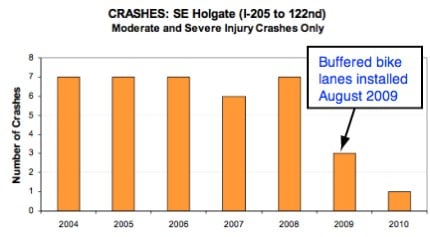
Looking to quell some of the neighborhood anger lingering around the buffered bike lanes installed on SE Holgate Blvd last year, the City of Portland Bureau of Transportation returned to the scene last night.
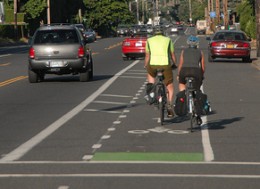
Armed with data from two years of post-project evaluation and a slew of complementary projects in the pipeline for the area — PBOT seems to have seriously turned the tide on this one.
BikePortland was not at the meeting, but we’ve gotten reports via PBOT staff and emails from readers who live in East Portland that attended the event.
While the statistics show clear benefits (more on that below), it’s also clear the project still has a few vocal detractors in the area (as our friends at KATU-TV were quite eager to focus on).
“Last night’s meeting was the first meeting where there appeared to be more people who strongly supported the safety improvements than asking us to restore Holgate to its prior conditions.”
— Greg Raisman, PBOT
At the meeting, PBOT apologized once again for their mishandling of the public outreach prior to re-striping the street. “Raisman started by apologizing for not doing better active outreach before initiating the project in the early stages,” reported reader Stephen R, “hopefully derailing the partisan alienation a bit, but I don’t think it mattered really.”
The criticisms from last summer seem to remain from those staunchly opposed to the project. At the meeting, they questioned the data presented by PBOT, and one of the primary jabs (and the focus of the KATU piece) is that no one is using the new lanes.
Overall, Stephen felt like the meeting “represented some good news in the face of that Holladay project and other setbacks lately.” His final impression? Of nearby residents, “70% were very happy, 25% probably didn’t care, and 5% were noisy and cranky.”
Reader Megan wrote in to say some in the crowd weren’t just cranky, they were downright rude. “The vocal group last night was extremely disrespectful to anyone who didn’t support their point of view,” she comments below, “calling out names while people commented and talking loudly during the roll-out of data. They were there to bully and intimidate.”
For their part, PBOT project managers Greg Raisman and Mark Lear both felt the meeting went very well. Lear told us the meeting was “amazing” and that there were “more supporters than people in opposition.” The primary reason many now support the project are the safety benefits.
Via email this morning, Raisman told us that, “Last night’s meeting was the first meeting where there appeared to be more people who strongly supported the safety improvements than asking us to restore Holgate to its prior conditions.”
“It appears,” Raisman feels, “that this change in sentiment has been driven by the documented overall safety improvements for all modes.”
PBOT spent nearly two years evaluating this project after it went in (an unheard of amount for a relatively small project like this; but it goes to show how important this project was for PBOT). The findings are eye-opening:
- a 24% reduction in speeding.
- 88 fewer people travelling over 50 MPH on Holgate each day.
- almost 550 fewer people traveling more than 10 MPH over the speed limit.
- prior to the project, PBOT counted approximately 7 injury crashes each year in the corridor. In the full year after the project, PBOT has seen 2 serious injury crashes in the corridor.
- auto volumes on Holgate (a neighborhood street) have gone down, and SE Powell (and arterial) seems to have absorbed the traffic (volume up 6.6% or 1,190 vehicles between 2008-2011).
[Download a PDF of PBOT’s presentation here.]
“This is an excellent result of improved safety on Holgate,” says Raisman.
Even after seeing the data from PBOT, some still weren’t convinced. “They did try to question the data gathering and statistical analysis,” reported Stephen, “but the evidence was rock solid.”
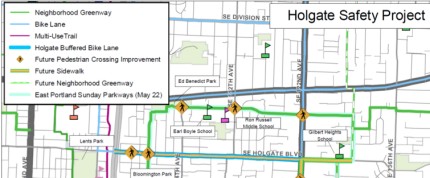
Beyond the buffered bike lanes, PBOT is giving the surrounding area a significant amount of attention and resources. At the meeting, Raisman detailed future plans for many new crossing improvements (at SE 97th and 100th) as well as sidewalk projects all along the corridor. They now call their effort the “Holgate Safety Project.”
Were you at the meeting? Feel free to chime in with your take on how it went.




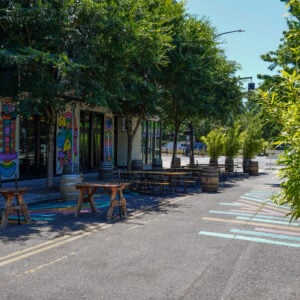
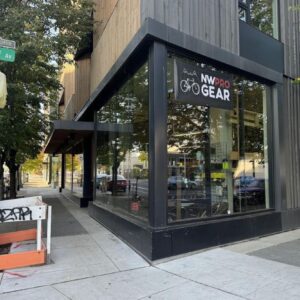
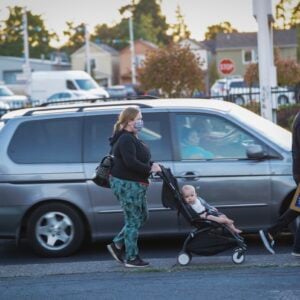
Thanks for reading.
BikePortland has served this community with independent community journalism since 2005. We rely on subscriptions from readers like you to survive. Your financial support is vital in keeping this valuable resource alive and well.
Please subscribe today to strengthen and expand our work.
Beautiful graph.
drat, I meant to go to this one and forgot to write it on my calendar, even though I moved from the area last month…
David Lentz is an a*s (I lived a half block from his shop), and the mail guy was parked on the sidewalk in the video… not the best spokespeople…
glad to see the safety numbers are favorable… but we already knew that was going to happen…
also glad to know they’re improving the pedestrian crossings… there are still a lot of angry people out there that think they shouldn’t have to stop for pedestrians… but there are a lot more people walking on the street now that MAX is there and traffic is buffered away farther from the sidewalk…
I was actually surprised on how small the attendance was compared to the last meeting. There was a group that didn’t seem happy with the methodology of gathering the bike counts, traffic light times, vehicle speeds even though they were the standard methods used around the city. The next argument was why the money didn’t go to schools or sidewalks and I think PBOT did a good job of reminding them that they are a traffic group and the money was earmarked for traffic and not schools. I was really pleased to see how measurably safer the roads were with the reduction of speeders and the injury accidents while still showing that >98% of the cars were making it through the lights on the first green and having to wait <45 seconds to turn onto Holgate from a stop sign. I don't know why people aren't seeing more bicyclists on the road as I have been seeing more and more in my commutes especially with the nicer weather. Just this week a group of 3 was ahead of me traveling east at 6:20 am and several individuals traveling west during the same time.
The city does need to do something where the bike lane starts on the 205 bridge heading west to make better. Until then, I am sticking to the sidewalk from the 205 path to the start of the Holgate bike lanes.
This mirrors the situation here in NYC regarding the protected Prospect Park West bike infrastructure. The changes resulted in decreased speeding and a decrease in injuries, while providing some great infrastructure for cyclists. Yet a small, but vocal, minority have managed to create a “controversy” around the lanes. Some people will not change their views despite all the data you present….
I lived just west of where these lanes went in on Holgate for several years. Great job PBOT!
Is the crash graph representative of all vehicles, or bikes only?
At least they did not refer to “accidents”.
If the graph is bikes only, I would be curious how much bike traffic increased (or not) before and after buffered lanes were installed. Especially so given the complaints about lanes not being used. That observation is probably mostly a few residents seeing what they want to see. Plus, when you “build it”, sometimes it takes time for “them to come”.
I understand that it represents reported traffic crashes, that could include bikes but probably motor vehicle injuries reported to the DMV.
major motor accidents: it’s a very dramatic graph.
KATU appears to like to play up cycling controversy, for ratings I assume. I remember a story not too long ago about an experiment where the city was converting two street auto parking spaces into sixteen spaces for bike parking. KATU presented it as “What do you think about the city taking away two parking spaces and giving them to bicycles?” instead of noting this could free up as many as 14 net parking spaces if drivers rode their bikes instead. Yeah, that may be a shaky statement but you can predict the response to the way it was presented before even seeing the results. Like we don’t have enough antagonism between cyclists and drivers already.
It’s funny to read the predictable comments on the KATU story; there are a lot of people claiming that they never see bikes there. Isn’t that what motorists always say after they right hook you?
KATU prefers Holgate residents get ran over.
The irony is that the city wants to put a bike lane on Sandy between 21st and 22nd. Could this be retribution?
Reducing crashes is great news. I do wonder about the unintended consequences, though. Crashes are down because volume is down. That means volume has been shifted to other routes. We really can’t know if safety has improved unless we factor in the effect on those alternate routes. If they absorbed the volume without an increase in accidents, then it is a true improvement. Otherwise, it is counterproductive.
volume was reduced by >2000, which primarily went to powell. percentage wise, it’s a huge jump that isn’t accounted by reduced volume alone.
lol@Mark
Well put!
The trend in crash reduction does not surprise me…past traffic studies show that making our local arterials simpler (one lane vs. two/ road diets), providing buffered lanes (buffering bike lanes/ parking lanes from sideswipe crashes) AND reducing the frequency of AGGRESSIVE driving (driving over 5 mph of the posted speed limit) helps make our roadways safer for all users and adjoining residents/ business owners.
This is why some of the design proposals to Williams (etc) are so important.
How is this remarkable reversal of public opinion possible? Could it be that critics’ concerns were ill-formulated, baseless knee-jerk fear reactions by people who had absolutely no previous knowledge or credentials in this area, yet still felt themselves perfectly eligible to “discuss” (i.e. loudly repeat) their opinions on the topic?
…which then get amplified by a news organization that seems to be operating in an effort to actively harm the community it is supposed to serve.
Oh fine! I’ll start adding 4 miles to my commute and swing South to Holgate so maybe some guy with his tailpipe in my face will see me using “his” bike lane… I’m starting to think we’re due for a “theme ride.”
This Lentz Automotive sure has dull customers if they can’t figure out how to cross a bike lane. He was probably taking advantage of those anyway, like a savvy mechanic.
Yeah PBOT! So happy that we have such solid data to push back with! Maybe more will begin to realize the depth to which speed is the killer, and traffic calming works wonders for providing safer streets! Re-framing the talking points HOPEFULLY will focus the neighborhood on what really matters about street changes.
That chart is amazing. This should be used as support for converting more 4/5 lane streets down to 3. It’s not about the bikes, it’s about the safety. Sandy, Foster, 39th -These could all be that much safer.
I was at the meeting to represent the viewpoint of someone who is not only a car and bike commuter who uses this route but also as a teacher at a school on Holgate past 122nd. More of my students would bike or walk to school if there was a safe way to get school.
Over the past few years I have noticed more cyclists on Holgate, and it just feels safer riding. PBOT’s data supports that. The vocal group last night was extremely disrespectful to anyone who didn’t support their point of view–calling out names while people commented and talking loudly during the roll-out of data. They were there to bully and intimidate. I found it funny and frankly just sad that they accused the City of not listening to their concerns but then did just that–not listen–when it wasn’t them doing the talking.
Is Lentz Automotive listed on Yelp or Angie’s List or anything?
Is the PBOT study information/ data publicly available for review outside of the meeting mentioned? Just a note: correlation is not causation. Certainly the lanes were a contributing factor but hopefully they controlled for others. Sometimes people can be a wee bit hasty in promoting anything that seems to shed a positive light on something they have already decided they are in support of.
This comment from the Oregonian story really shows us what we are working against here. The commenter first said there were no bikes using the new lanes, when someone pointed out that the city used video to count the number of cyclists using the lane, and that it was nearly 200 in one day.
His response: “Except only the uninformed would believe any statistic coming from the agency that is pushing this nonsense.”
How do you work with someone who is so opposed to the city doing anything that they refuse to believe any data the city collects, even counts that are backed up by video tape of the entire day? The opposition to these safety projects is a small group of people who think that the city of Portland is part of some giant conspiracy to do who knows what led by the Mayor, I don’t see how anything can change their minds.
While KATU showed up at the meeting, they didn’t take the time to interview the ardent supporters who were in the room, perhaps because it would be totally imploded their narrative.
These improvements have led to safer conditions for people in cars, bikes and on foot.. and I just can’t fathom the bang-for-the-buck they got out of this one. Road diets = big safety at a small cost.
How do you have a rational debate with an individual or group that invents their own data and flatly denies the truth of objective 3rd party data?
Once you exhausted all calm methods of logical and rational speech,
have digressed downward towards Ad-speech and marketing spin,
then further towards screaming and insults: what then?
When people choose to intellectually insulate themselves from reality are the only choices the strong arm of the Law or naked violence?
Riding down Holgate naked should help them notice the bike lanes being used.
It cracks me up… we have gone from a bike lane project that was never well thought out to a “safety Project”. How cute.
The reason the ridership on Holgate is so small, is because the bike lanes do not service a valid destination. If some thought had been put into this, we could have had a bike route that went from the outer southeast area all the way down to the core. Instead, we blow 30,000 of Tri-Mets dollars on an extravagant bike lane that runs 30 blocks with nothing of significance on either end.
Another interesting fact is that Holgate has never identified in the past as a safety problem. Foster has been repeatedly sighted by neighorhood associations as a street that is unsafe and needs help.
This is just someones pork project that the city has to now justify. And if you think the residents out here have somehow become happy with all of this, stand by for the poll that will be released sometime soon.
Neighbor:
I live off Holgate, so I consider it a valid destination. Businesses along 122nd consider themselves valid destinations. Everyone taking the MAX or the 205 bike path considers those valid.
But I agree with you on Foster being unsafe. It’s also ripe for redevelopment, and businesses could benefit from wider sidewalks and bike lanes (whether or not streetcar comes back).
I live off Holgate and I have a bunch of valid destinations I reach by traveling along Holgate:
The Taco Truck at 122nd and Holgate
The Takahashi
All About Heroes
Lents Village & the Loaves and Fishes at 104th
The Holgate MAX Station
Bloomington Park
Lent Elementary
Leander Court
Earl Boyles Elementary
Ron Russell Middle School
Ed Benedict Park
The Portland Memory Garden
Zenger Farm
Leach Botanical Garden
Tina’s Corner (PIE!)
A bunch of my friend’s homes (BBQ season is almost here!)
And that’s just what I travel East to reach. I have a lot of friends and acquaintances that live East of the freeway and they travel West on Holgate to reach all of the stuff by my house:
Eastport Plaza = Movie Theater, WalMart, LA Fitness and multiple banks, restaurants, personal services and shopping destinations
The Holgate Library
Lents Park
Marshall High School
So, “neighbor” – which I’m guessing is Rick or the worst postal carrier I’ve ever had (dude, you habitually wrinkled and tore my magazines and I have a large, USPS regulation mailbox), maybe you need to spend a little more time looking, and a little less time talking smack. Who knows, you might even start seeing all of the folks on bicycles, including myself that see you all the time.
As far as safety goes – it’s pretty well documented that 82nd and Holgate is a major high-crash intersection. And, the speeds on Holgate as you approach 82nd greatly contribute to that problem. In addition, the “no bikes on Holgate” phenomena that you like to use as a justification to consider Holgate a “highway” (according to Mr. Lentz in his KATU interview) rather than a neighborhood collector street, is an key indicator that the street does not provide safe accommodations for pedestrians and cyclists.
Cora +1!
neighbor, maybe you weren’t paying attention at the neighborhood association meetings. this has been in the works for years.
unfortunately, the city reduced the street and added a bike lane at the same time, so it looks like they were related, BUT THEY’RE NOT. it was just a convenient way to do two things the neighborhood had been asking for at the same time.
are you saying holgate should be a street like division or 122nd? because that’s the way it was configured, and it sucked. it was a mistake. they’re fixing it now, the way the neighborhood asked them to do.
The neighborhood association (lents, at least) asked for bike lanes on Foster and Holgate. What they got was nothing like what they asked for. We have had 4 lanes out here for many years and it never has resembeled Division. For some reason some think it is a shame if we have a street that ISN’T congested. It was always nice to know that on my trips, when I would get to Holgate it would be easy going. Now it is congested from one end to the other.
If indeed holgate was so dangerous, why isn’t it listed in any of the police bureaur reports as a trouble spot. Why was there never satruation patrols? Why does the crash data from the last 10 years show it as being relatively safe? Safety has nothing to do with this except as a way of justifying something that was never inteneded to be a safety project.
Now if I were a bike rider, I think I would be pushing for a much more meaningful solution, as far as bike transportation goes. You’ve gotten ripped off on Holgate. That much money, effort and time could have gotten you a bikeway that could have really gotten you somewhere!
Neighbor, I remember the neighborhood association asking for a reduction in lanes, too. PBOT admitted it was a mistake to widen them in the first place, since the 205 on-ramps onto Holgate were never built.
I don’t know if you’ve been to all the PBOT Holgate meetings, but at each one, several residents who live directly on Holgate been vocally grateful that the street is calmer and safer. Less property damage to their cars and houses, too.
I would hardly call Holgate congested, even at peak hours. Holgate was one of my favorite streets to drive before the conversion, and it still is now. Honestly, it feels much more orderly and yet still open and easy.
And I don’t understand why you keep saying Holgate doesn’t go anywhere when several people upthread have told you where it take them. To add to their voices, I can say Holgate takes me to my job and pretty much anywhere West of 136th, regardless of whether I am driving a car or riding a bike.